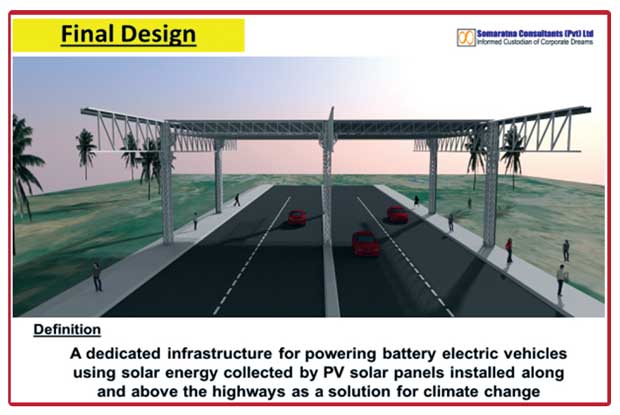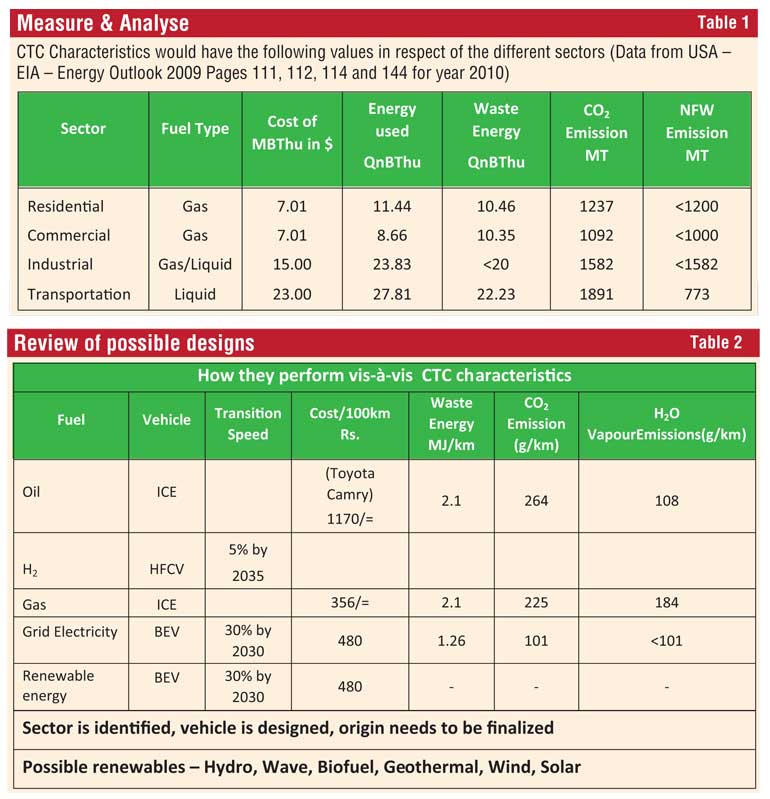Tuesday Oct 21, 2025
Tuesday Oct 21, 2025
Thursday, 11 January 2018 00:00 - - {{hitsCtrl.values.hits}}

Introduction
During the last six months, I have written seven articles to Sri Lankan papers criticising (i)Paris Accord for putting the onus of finding solutions for climate change on to the individual countries and (ii) UNFCCC and IPCC for spending 20 years on researching climate change without identifying a single solution which could be applied universally to solve climate change. But today I am happy that UNFCCC and IPCC have accepted their inability to do so and providing opportunities to individual countries to find their own solutions.
My objective for this article is to show how one could arrive at a solution for climate change using Six Sigma Methodology. It is strange that Western corporate leaders who have gained gigantic financial benefits for their companies from Six Sigma methodologies – I am reminded of how Jack Welch, the famous CEO of General Electric came for a Six Sigma meeting dressed like a Karate Black Belt – have not pressed that we use Six Sigma methodology to find a solution for climate change. 
In fact, Jack Welch wrote in his much-publicised letter to shareholders in February 1999 that “Six Sigma will be the biggest, the most personally rewarding and in the end, the most profitable undertaking in our history… We have invested more than a billion dollars in the effort and the financial returns have now entered the exponential phase.”
Unlike other more common quality management initiatives, Six Sigma has been developed into a complete array of new techniques leading up to and not limited to Six Sigma DMADV2 (Define, Measure, Analyse, Design, Verify and Validate) methodology with astounding results for the companies using these. Though neither green belts nor black belts, we have been providing Six Sigma consultancy services and one of our recent assignments was to carry out a Measurement System Analysis (also called Gauge R & R Analysis) for de La Rue Security Printers – local outfit of the international currency notes printer at the Biyagama Zone – completing the assignment for 23 instruments in exactly 40 working days as per the project schedule. They had been struggling to find a local consultant to do this for quite some time

Application of Six Sigma methodology
Now I wish to show how we applied Six Sigma Methodology known as DMADV2 methodology to identify a solution for climate change. It started with the first phase called Define phase and here I used that definition provided by International Energy Agency in the first paragraph of the Executive Summary of their Energy Outlook 2009 document.
It said that “It is no exaggeration that future of human prosperity depends on how successfully we tackle the following two central “energy challenges” facing us today:
(1) Securing reliable and affordable energy and
(2) Rapid transition to (a) low carbon (b) energy efficient and (c) environmentally benign form of energy”
Then I had to identify the Critical to Climate (CTC) characteristics of this process of providing energy using fossil fuels which form the core of the current day climate change crisis. For this purpose, I depicted the energy generating process as indicated in figure I, identifying Inputs for the process, process itself and outputs from the process.
We identified seven potential CTC characteristics stemming from the statement by the IEA as follows: a) reliability, b) affordability, c) carbon content, d) energy efficiency, e) carbon dioxide generated, f) water vapour generated and g) waste heat generated. Out of these seven, reliability and affordability stem straight from the IEA document and so does energy efficiency as well.
The concern of being environmentally benign was interpreted as not influencing the environmental balance associated with components of the climate system and three climate parameters temperature, precipitation and wind. These CTC characteristics will influence the values of (1) extents and / or (2) quality of atmosphere, biosphere, cryosphere and hydrosphere, temperature, precipitation and wind. Climate change was defined using these statements.
The CTC characteristics should also stem from the usage of fossil fuels. We then discarded carbon content as it is again captured by carbon dioxide emitted which is a much easier characteristic to measure, monitor and grasp. Furthermore, what influences the seven components of the totality of climate system was not the amount of carbon in the fuel; but how much of carbon dioxide is being emitted.
We also discarded energy efficiency as waste heat generated is also an indicator of the same; higher the energy efficiency, lower the waste heat generated. Then the three parameters which influences the climate system were found to be (1) carbon dioxide emitted – that is the parameter which is over-emphasised, (2) Newly Formed Water (NFW) vapour emitted – the most ignored and neglected although it influences (a) atmosphere by reducing oxygen content in air and being a Greenhouse gas, (b) hydrosphere by ultimately ending up there, (c) cryosphere by enhancing the temperature more than carbon dioxide (d) biosphere by actively engaging in all biogeochemical processes (e) temperature by contributing to its enhancement (f) precipitation by directly leading to precipitation (g) wind by reducing wind shear more than other three gases (O2,N2,CO2) and (3) waste heat given by the fossil fuel while providing energy for an anthropogenic use. The moment we realised this significance of NFW vapour in this approach, we lost all our faith in the research done by climate scientists concentrating on carbon dioxide and temperature.
Then an analysis was carried out on the four sectors – commercial, industrial, residential and transportation – to identify the sector, that needs to be addressed first, in order to speedily bring significant benefits in respect of CTC characteristics. The outcome of this analysis is shown in Table 1. It was found that gasoline-fuelled transportation is the most significant contributor to climate change. Cost of Million British Thermal Units – MBThu – is an indication of affordability of the energy.
Please note that in residential and commercial sectors only natural gas and electricity were used and waste energy given is what corresponds to the waste associated with the electricity used. In the case of industrial sector other fuels are used and the value of waste energy is an estimate on the high side. Because electricity and other fuels are used in these three sectors, NFW emission is given as being less than CO2 emitted. Liquid fuels and natural gas generate one (18kg) and two (36kg) molecules of NFW respectively for each molecule (44 kg) of CO2. In the case of transportation, only oil is used – this was prior to President Barak Obama’s promotion of gas-fuelled transportation – and NFW is based on that while waste heat is taken as 80% of energy in the fuel as per thermal efficiency figures quoted in literature.
Then the process from well to wheel was broken down into different production phases from extraction to the step where energy in the fuel in the tank is converted to energy turning the wheel and this last phase was found to be the one making the most significant contribution to the environmental damage in respect of CTC characteristics.
In the next step the tank to wheel step was studied using Root Cause Analysis where the four aspects Man, Material, Method and Machine were analysed to see which component makes the most significant contribution to the CTC characteristics. (1) Characteristics like mental state of the man, arrogance, etc., (2) material aspects corresponding to petrol Octane 92, Octane 95, Auto diesel and Super diesel, (3) aspects corresponding to driving methods and (4) specifications corresponding to the internal combustion engine – both petrol and diesel – were then considered to find that it is the Machines which influence the CTC characteristics the most.
Then we got into the design phase and we started reviewing designs available to replace the ICE powered vehicles and the corresponding fuel combinations using the same CTC characteristics and it was found that Battery Electric Vehicle-Renewable Energy combination to be the most advantageous combination.
Please see Table 2 – This table is based on data given in World Energy Council’s document called ‘Transport Scenarios in 2050,’ Ph.D. Thesis at MIT titled ‘On the Road in 2035,’ the three objectives pronounced at UN Climate Summit in September, 2014 and current prices in Sri Lanka. Row corresponding to Hydrogen Fuel Cell Vehicle (HFCV) was not completed due to uncertainties associated with the path to obtain the hydrogen. There are two ways of obtaining hydrogen; namely by electrolysis of water and by steam reforming of natural gas. Both do have inefficiencies as follows:
If electricity is available from renewable sources, it could be used to power Battery Electric Vehicles at 95% efficiency while HFCV will give us an efficiency of 48% only. If natural gas is to be used to get hydrogen, then it could power an ICE vehicle directly generating CO2 and NFW, without first converting gas to hydrogen using steam and then converting it in fuel cell. Both processes will generate CO2 and NFW at least to the same extents; but the second is less efficient.
Of course, renewable energy sources themselves have so many options like hydro, solar, wind, geothermal, etc. and solar is the most favourable in respect of the extent of availability and reliability. Even in respect of solar, there are different technologies like photovoltaic solar and concentrated solar thermal, etc. For concentrated solar thermal one needs a minimum level of solar radiation and PV solar would be the preferred solution for Sri Lanka.
The question which arises then is where the required PV solar panels could be installed and Dr. Marc Jacobbsson of Stanford and Dr. Mark Dalucci of California at Davis in their Wind, Water and Solar (WWS) infrastructure have suggested rooftops and solar parks to provide energy for vehicle electrification and other energy uses. They have even calculated land area that would be required for the same. The issue with solar parks is that you need to carry out deforestation at the rate of about 1.8 hectares per megawatt and this would reduce (a) possible reflection of shortwave radiation (b) absorption of carbon dioxide by vegetation and (c) conversion of solar radiation to chemical energy during photosynthesis – all three enhancing climate change.
What we propose is laying PV solar panels along and above the highways – we call it highway solarisation – and use that electricity to power Battery Electric Vehicles. This particular solution has many significant advantages in addition to giving the best possible values for the CTC characteristics.
The solution
As such this most powerful technique of Six Sigma DMADV2 has provided us a very good solution for climate change in Battery Electric Vehicles associated with highway solarisation. It would completely eliminate generation of carbon dioxide, NFW vapour and waste heat currently associated with vehicular transportation
We have carried out the first five phases of DMADV2 methodology (Define, Measure, Analyse, Design, Verify phases) to solve this issue of climate change and has arrived at this solution of highway solarisation and yet to carry out the validation of the solution. We are awaiting approval from related government agencies for the validation phase and once it is completed, highway solarisation will become a completely proven and confirmed mitigation solution which will eliminate climate change due to fossil fuel driven transportation – the most significant source of greenhouse gases as at today.

Implementation issues
When one looks at the situation in the proper perspective, one would notice that PV solar’s capability to assist in generating energy for mankind and make fossil fuel oil usage obsolete was a known thing for quite some time. But at the beginning it was conceived to be a small scale or rather domestic phenomenon and the changeover rates and duration were calculated based on the same. That is why oil company executives were scoffing that even after 30 years, the penetration of PV solar would be only about 5%.
Then the concept of PV solar parks and megawatt installations became common. Even then the large areas required and deforestation required were adequate deterrents to prevent large-scale proliferation of the same and the possibility of mankind quenching its thirst for energy using renewables was in doubt. Concept of WWF infrastructure mentioned above cleared those doubts and its authors managed to convince everybody that the global energy requirement could be fulfilled using the WWS infrastructure. Still getting so many rooftop solar panels installed and so many solar parks installed in different countries with different forest cover regulations appeared to be somewhat difficult to achieve and the oil companies did not see a possibility of them getting into that small-scale business.
Highway solarisation – with so many highways available across the world and no special approvals being required – could become an industry which oil companies would readily invest in and reap benefits in line with Investments. What they need to remember is that they should develop a new business model for the operation and they don’t need to dig thousands of meters down to get energy when the sun bestows upon them millions of kilowatt hours every day to quench the thirst for energy.
Highway solarisation could be implemented very fast even up to a few TerraWatt hours and it would bring significant revenue very fast. As they establish generating capability to this level they can manipulate prices to match their targets for return on investment. They need to remember that the price paid by an I C E vehicle owner for unit energy actually used is very high and the oil companies can charge significant prices for the energy they develop and the users should not be complaining bearing in mind the fact that the oil companies are doing a great service to mankind by saving them from the imminent travails of climate change.
How well they carry out that task will determine whether they would remain at the same positions in the Fortune 500 listings or they would move out just in the same fashion many other corporate giants have moved out in the past.
New York Times recently carried a news item about a statement from the reinsurer Munich Re to say that insurers lost nearly $135 billion in 2017 due to the natural disasters attributable to climate change. The news item also mentioned that the overall loss was about $ 330 billion. Generally, insurers invest the premiums received in profitable ventures to generate funds to pay for the losses incurred by the insured.
So, does it not mean that reinsurers like Munich Re stand to gain a lot by investing in Highway Solarisation. On one hand they would obtain the normal returns arising from the projects and they would be eliminating a significant portion of the insurance claims and they would be making our Loved Planet Earth a better place to live. This would be the finest example of demonstrating their dedication to the Triple Bottom Line.
If we in Sri Lanka invest a billion dollars – equivalent to what G E under Jack Welch invested in Six Sigma – in highway solarisation – again a Six Sigma initiative – and establish about 700 megawatt of PV solar power on Southern Expressway and the energy generated – 1050GWHrs per year – is used to power 400,000 BEVs at 15000 kms per year, we would be saving $170 million per year on our oil bill and after six years that power will be almost free – the exponential phase Jack Welch spoke about - for our small island nation with so much of development plans like tourism industry, Port City project, etc. This of course is on the assumption that oil prices don’t go up in the interim.
May this be my gift to mankind for the year 2018.
What is better: Lighting this lamp or keep on cursing the darkness of climate change?
(The writer is Managing Director of Somaratna Consultants Ltd.)
Footnotes
Reference: Design for Six Sigma for Green Belts & Champions by Dr. Howard S. Gitlow, Dr. David M. Levine and Dr. Edward A. Popovich.